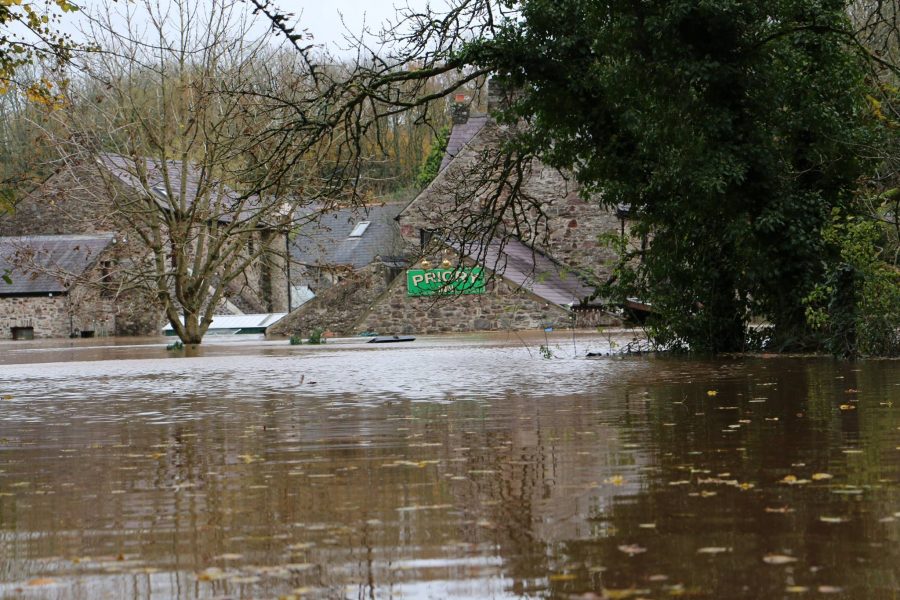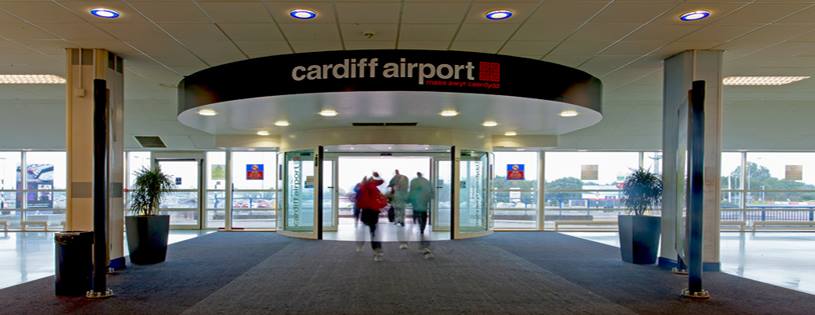News
Flood victims round on Port Authority

UNHAPPY homeowners from Havens Head and Lower Priory vented their anger and frustration at Pembrokeshire County Council and Milford Haven Port Authority at a special meeting of a Council scrutiny committee this week.
Chair Rob Summons convened the extraordinary meeting of the Council’s Services Overview and Scrutiny Committee for Tuesday (July 21), after a report into devastating floods which struck the hamlets near Milford Haven in November 2018.
Cllr Summons’ wanted to allow residents, who did not get the report in time for the Committee’s June meeting, to contribute to the Committee’s discussions.
Neither the Port nor the Council is prepared to accept any responsibility for the flood. The report’s content focussed, therefore, on possible preventative measures to avoid a repeat of them.
CAUSES IDENTIFIED
The report concluded a combination of a rapidly rising watercourse, silting in the pills, high water levels in them after heavy and sustained rainfall, the low capacity of the culverts, and high tide levels all contributed to the floods.
The report notes the drainage system’s complexity and the poor condition of much of its infrastructure.
The local authority reviewed a report prepared for the Port Authority by civil engineering firm Atkins last June. Atkins’ report recommended the Port Authority should significantly increase the width of the culverts to cope with increased volumes of water run-off.
At the time, several councillors asked if, as the Port Authority claims, the existing culverts are adequate and fit for purpose, why Atkins recommended their size should be increased to handle three times the volume of water for which they’re currently designed.
LOCAL FURY
Ian Bannister, who lives in Lower Priory addressed Tuesday’s meeting.
He said critical assumptions made in the report about the extent of the previous flooding were flawed. Mr Bannister said in the week before the events of November 7-9, 2018, the pills were already full to overflowing. Water in the Lower Priory Pill was at such a level, Ian Bannister said, the footpath leading to Havens Head was inundated.
He also told committee members that repeated requests to open the sluice gates to reduce the flooding’s severity were ignored and one of the sluice gates supposed to release water from the pills had been broken for ten years and was only now being repaired.
Neither the Port Authority nor Council Officer Darren Thomas was having any of it.
Rocking back and forth in his chair, hands behind his head, and staring at the ceiling while answering questions was not a good look for Mr Thomas, in particular. He gave the unfortunate impression of not being much interested in anything Mr Bannister had to say.
Metaphorically patting the Council on the back for its response to the flooding appeared confused by Darren Thomas with a proactive role in preventing it.
Appearing on behalf of the Port Authority, Chair Chris Martin and Chief Executive Andy Jones, determinedly stuck to the line that it wasn’t them, guv.
Acutely aware of the litigation risk it faces if it concedes even an inch, the Port Authority’s approach is to brickbat any suggestion of contributory fault on its part. Conditions of the culverts were less than ideal but had no effect on the flooding. A valve in the system which didn’t work properly had nothing to do with the backflow of water. A failure to drain the pills over the preceding days, of little or no effect. Defective sluices and failure of water measurement equipment, nothing to see there.

Emotional moment: Ian Bannister from Lower Priory clearly upset by the damage caused (Pic: Herald)
REPORT DID NOT PLAY BLAME GAME
While Ian Bannister might have felt like he was banging his head against a brick wall trying to get to the heart of the matter, getting to the heart of the matter was something the Capita report didn’t address and an issue which its authors were not asked to address.
Capita was not asked to assess who, if anyone, was to blame; presumably, in case they could and were able to apportion it.
Sticking to the narrow technical criteria of their brief, Capita conducted flood modelling, produced options based on that modelling, costed those options, and provided conclusions accordingly.
And it was the conclusions which took some swallowing; especially the one recommended to the Council.
Although the report recognises engineering options could be used to help alleviate the flood risk it notes the options for doing so are expensive and would require further justification to the Welsh Government to secure funding.
Capita’s economic assessment says a flood alleviation scheme would be difficult to justify over and above what it describes as ‘Business as Usual’.
That option involves sustaining the current Welsh Government Flood and Coastal Erosion Risk Management arrangements including routine maintenance or inspections of flood and coastal defence systems, or doing the (bare) legal minimum where there is a statutory requirement to continue them.
It accepts flood risks affecting several residential and commercial properties but does not take into account rising sea levels, the increased frequency of extreme weather events, or the continuing development at Milford Haven Docks.
As Ian Bannister pointed out, the area of land on which the Port Authority wants to build a car park for its proposed hotel development was flooded by raw sewage washed down from the pills in November 2018. That does not appear to have been factored into the Port’s hotel plan, dealt with in the drainage assessment for the development and relayed to the Council’s Planning Committee.
The report concludes, however, the potential exists for a flood alleviation scheme in Milford Haven as there are economic benefits of undertaking one. It recommends further work is to cost a scheme and refine one’s economic viability.
COUNCILLORS TAKE AIMAT PORT AUTHORITY
When the time came for councillors to respond to the report and what they had heard in response to residents’ concerns, questions became even more pointed.
Cllr Viv Stoddart said she wanted to look at potential solutions.
Referring to a recommendation in the report, which suggested replacement of the existing Havens Head culvert section with a slightly larger circular concrete culvert of and building a new section to discharge into the Port, she asked for confirmation of the works estimated costs.
Responding Council Engineer Emyr Williams confirmed the cost estimate was £3.4m but added he regarded that as an optimistic cost because of the poor state of the made-up ground. She asked whether some form of joint-venture would be possible.
Based on her local knowledge of the areas affected, Viv Stoddart drew councillors’ attention to the content of a sentence in the report’s conclusions: ‘It can be said in summary that the culvert is the primary cause of flooding in Havens Head and Lower Priory’. Mrs Stoddart said it was her view and other residents’ views going back many years that the culverts were inadequate and could not cope with periods of very heavy rain.
Cllr Stoddart drew attention to the extent of backfilling at Goose Pill, going back as far as the 1970s and assumptions made in an appendix presented to the meeting which said were unsubstantiated assertions. Viv Stoddart said, in her view, liability rested with the Port Authority and its predecessors in title over the land it now owned. She added to rely on insurers declining to pursue the Port Authority as evidence the Port Authority was not liable ignored the litigation risk and cost of pursuing proceedings against it.
Cllr Mike Stoddart suggested the backfilling of the pills was a substantial issue. Backfilling the pill, he said, inevitably increased the pressure on the culverts and reduced their effectiveness and moving water. He added the original culverts were much shorter and their increased length was necessitated by the effects of backfilling which reduced the pills’ ability to handle excess water. Mike Stoddart compared the effect of backfilling reducing the capacity of the lake to sinking six concrete blocks in a bath and watching it overflow in short order.
Cllr Stoddart drew members’ attention to an alteration made to both the direction of the Havens Head culvert and a reduction its width. Emyr Williams said he agreed the hydraulics of the system were ‘less than satisfactory’. Mike Stoddart suggested that work be commissioned to see if the diversion of the Haven Head culvert to discharge directly into the Docks would – at least – partly address the flood risk.
He pointed out the Port Authority had done very well out of its ownership of the land, as had the previous Milford Docks Company. The Port Authority, he said, should not be allowed to ignore problems which arose as a result of its actions or inaction.
COMMITTEE WANTS MORE INVESTIGATIONS
Cllr Rhys Sinnett raised an ‘easy win’ the report identified, which suggests artificially and permanently lowering the pills’ basins, to create an increased storage volume.
Capita’s representative, John Greenier, said that option was part of a suite of solutions which could have a considerable cost.
Cllr Stephen Joseph said had it not been for the Fire Service pumps removing 14,000 litres of water a minute from Havens Head, the buildings there would have been inundated at an extraordinary cost. He pointed out the Fire Service were not there as an insurance policy for a landowner which failed to act to protect its own property. He observed that modern practice built-in flood attenuation as standard and infill, as took place in the past, would not happen now.
Cllr Joseph added the report needed to go back to Cabinet to find out what money was available for further investigations and the ‘business as usual’ recommendation should be rejected.
Supporting the suggestion, Cllr Di Clements said the Cabinet needed to put its money where its mouth is and commission a fresh look at the problems.
Cllr John Preston said a number of agencies were involved and each was passing the buck. He said ‘business as usual’ was what created the problem in the first place.
Cllr Rob Summons moved a recommendation that the Committee send the report to Cabinet for further action and examination of options.
The Chair’s recommendation carried unanimously.
News
Angle RNLI launch stood down after false distress beacon alert

ANGLE RNLI were paged at 10:47am this morning after an EPIRB (Emergency Position Indicating Radio Beacon) was triggered on a local fishing vessel in the Dale Roads area.
Dale Coastguard Rescue Team was also tasked to investigate the alert.
As the lifeboat crew prepared to launch, further checks by HM Coastguard — along with direct contact from the vessel’s skipper — confirmed the beacon had been activated accidentally.
With no-one found to be in difficulty, the launch was cancelled.
Business
Cardiff Airport announces special Air France flights for Six Nations

Direct services to Paris-Charles de Gaulle launched to cater for Welsh supporters, French fans and couples planning a Valentine’s getaway
CARDIFF AIRPORT and Air France have unveiled a series of special direct flights between Cardiff (CWL) and Paris-Charles de Gaulle (CDG) scheduled for February 2026.
Timed to coincide with two major dates — the Wales v France Six Nations clash on Saturday 15 February and Valentine’s weekend — the flights are designed to offer supporters and holidaymakers an easy link between the two capitals.
For travelling French rugby fans, the services provide a straightforward route into Wales ahead of match day at the Principality Stadium, when Cardiff will once again be transformed by the colour, noise and passion that accompanies one of the tournament’s most eagerly awaited fixtures.

For Welsh passengers, the additional flights offer a seamless escape to Paris for Valentine’s Day, as well as opportunities for short breaks and onward travel via Air France’s wider global network.
Cardiff Airport CEO Jon Bridge said: “We’re thrilled to offer direct flights to such a vibrant and exciting city for Valentine’s weekend. Cardiff Airport is expanding its reach and giving customers fantastic travel options. We’ve listened to passenger demand and are delighted to make this opportunity possible. There is more to come from Cardiff.”
Tickets are already on sale via the Air France website and through travel agents.
Special flight schedule
Paris (CDG) → Cardiff (CWL):
- 13 February 2026: AF4148 departs 17:00 (arrives 17:30)
- 14 February 2026: AF4148 departs 14:00 (arrives 14:30)
- 15 February 2026: AF4148 departs 08:00 (arrives 08:30)
- 15 February 2026: AF4150 departs 19:40 (arrives 20:10)
- 16 February 2026: AF4148 departs 08:00 (arrives 08:30)
- 16 February 2026: AF4150 departs 16:30 (arrives 17:00)
Cardiff (CWL) → Paris (CDG):
- 13 February 2026: AF4149 departs 18:20 (arrives 20:50)
- 14 February 2026: AF4149 departs 15:20 (arrives 17:50)
- 15 February 2026: AF4149 departs 09:20 (arrives 11:50)
- 15 February 2026: AF4151 departs 21:00 (arrives 23:30)
- 16 February 2026: AF4149 departs 09:20 (arrives 11:50)
- 16 February 2026: AF4151 departs 17:50 (arrives 20:20)
Crime
Mother admits “terrible idea” to let new partner change her baby’s nappies alone

Court hears from timid mother who was barely audible in the witness box who said she carried out no checks to establish whether Phillips was safe to be around her child
A MOTHER who cannot be named for legal reasons gave evidence yesterday in the trial of Christopher Phillips, the man accused of physically and sexually assaulting her infant son – referred to as Baby C – and causing him life-changing injuries in January 2021.
Phillips, 37 at the time, had been in a relationship with the mother for only a few weeks when Baby C, then around 10 weeks old, suffered catastrophic anal injuries at a flat in Haverfordwest, Pembrokeshire. The child was rushed to Glangwili Hospital in the early hours of January 24 and survived, but the harm was permanent. Phillips denies 11 counts of sexual penetration of a child under 13, four counts of causing grievous bodily harm with intent, and one count of assault occasioning actual bodily harm, all between December 20, 2020, and January 25, 2021. The mother denies two charges of causing or allowing a child to suffer serious physical harm and two charges of child cruelty by neglect.
The prosecution alleges that Phillips deliberately inflicted the injuries while alone with the baby during nappy changes, using a finger coated in Sudocrem as lubricant on multiple occasions, leading to escalating harm including blood in the nappies and ultimately a massive tear and prolapse. A central part of their case is that the mother repeatedly allowed Phillips unsupervised access to her son – including taking him into another room to change his nappy and shut the door – despite knowing very little about him and despite behaviour that should have raised alarm, such as his insistence on privacy and her own unease.
Late on Thursday morning (Dec 4), under lengthy and forceful cross-examination by Caroline Rees KC, prosecuting, the mother appeared composed but spoke so quietly and timidly that people in court struggled to hear her answers. She conceded point after point:
- She carried out no checks to establish whether Phillips was safe to be around her child.
- She allowed him to be alone with Baby C from the very start of January 2021 (possibly even before 2 January).
- She ignored her own concerns and permitted Phillips to shut the door while changing the baby’s nappy, telling her not to enter or accusing her of “micromanaging”.
- She accepted that this had exposed her son to “a massive risk” and had been “a terrible idea”.
The mother explained that Phillips had said he wanted to learn nappy-changing because he “never got the chance” with his own child. She initially stayed in the room but soon permitted him to take Baby C into a separate room alone. She also recounted noticing odd details during changes, such as Phillips having Sudocrem around his finger “as if it had come from a pot” – despite her not owning a pot of the cream – and him leaving the room without putting the baby’s babygro back on after fastening the nappy, which immediately struck her as wrong. A few days earlier, she had discovered extensive bruising to the baby’s bottom, a swollen testicle and blood in his nappy, prompting her to confide in family and seek medical advice, though Phillips became angry when she mentioned the appointments.
Key moments from the cross-examination
Caroline Rees KC: “You took no steps whatsoever to keep Baby C safe, did you?” Mother (barely audible): “No.”
Caroline Rees KC: “You did absolutely nothing to keep him safe, did you?” Mother: “No.”
When His Honour Judge Paul Thomas KC asked her to clarify for the jury why she let Phillips change the baby alone, she confirmed:
“I wasn’t allowed in the room. If I tried to go in he would accuse me of micromanaging.”
She said this made her feel “annoyed”, but she “ignored it”.
Caroline Rees KC put it directly to the mother:
- “The signs were all there, weren’t they?”
- “It was a terrible idea, wasn’t it?”
- “You could have stopped it at any time – by doing the changes yourself or by ending the relationship.”
- “This man wanted to have your baby on his own more than is normal.”
The mother eventually accepted each proposition, agreeing that:
- Allowing Phillips to change the baby alone had been “a terrible idea”;
- The warning signs that she should have stopped it were present;
- Phillips’ desire to be alone with her son was greater than normal.
She admitted she had been “keen to have company” and had tolerated behaviour she should never have accepted.
Legal matters will be dealt with tomorrow morning only. Closing speeches are expected to continue into Monday.
The trial continues.
-

 Crime2 days ago
Crime2 days agoDefendant denies using Sudocrem-covered finger to assault two-month-old baby
-

 Crime6 days ago
Crime6 days agoMan denies causing baby’s injuries as police interviews read to jury
-

 News1 day ago
News1 day agoBaby C trial: Mother breaks down in tears in the witness box
-

 Crime24 hours ago
Crime24 hours agoPembroke rape investigation dropped – one suspect now facing deportation
-

 Crime7 days ago
Crime7 days agoMan denies injuring baby as jury hears police interview in ongoing abuse trial
-

 Crime2 days ago
Crime2 days agoLifeboat crew member forced to stand down after being assaulted at Milford pub
-

 Crime2 days ago
Crime2 days agoDefendant denies causing injuries to two-month-old baby
-

 Crime2 days ago
Crime2 days agoPembrokeshire haven master admits endangering life after speedboat collision





























